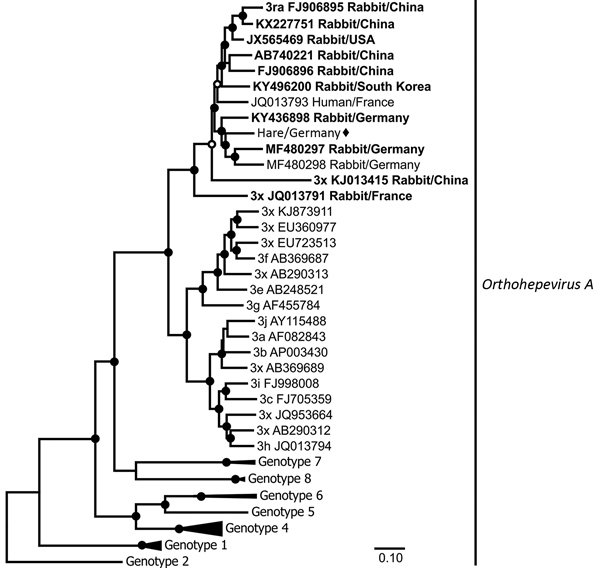Volume 25, Number 6—June 2019
Research Letter
Hepatitis E Virus Infection in European Brown Hares, Germany, 2007–2014
Figure

Figure. Maximum-likelihood phylogeny of the concatenated open reading frame 1 and 2 nucleotide sequences of hare hepatitis E virus (HEV) strain from Germany (black diamond), related strains from rabbits (bold) and humans, and reference Orthohepevirus A strains, as defined by Smith et al. (7). Taxon names of all reference sequences include genotype, subtype (x if not available), and GenBank accession number. Black circles at nodes indicate bootstrap supports of >90% and white circles >75% (1,000 replicates). The clades comprising sequences other than HEV genotype 3 were collapsed for graphical reasons. Scale bar indicates nucleotide substitutions per site.
References
- Aggarwal R. The global prevalence of hepatitis E virus infection and susceptibility: a systematic review. Geneva: World Health Organization; 2010.
- Abravanel F, Lhomme S, El Costa H, Schvartz B, Peron JM, Kamar N, et al. Rabbit hepatitis E virus infections in humans, France. Emerg Infect Dis. 2017;23:1191–3. DOIPubMedGoogle Scholar
- Izopet J, Dubois M, Bertagnoli S, Lhomme S, Marchandeau S, Boucher S, et al. Hepatitis E virus strains in rabbits and evidence of a closely related strain in humans, France. Emerg Infect Dis. 2012;18:1274–81. DOIPubMedGoogle Scholar
- Chapman JA, Flux JEC; International Union for Conservation of Nature and Natural Resources. Lagomorph Specialist Group. Rabbits, hares, and pikas: status survey and conservation action plan. Gland (Switzerland): International Union for Conservation of Nature and Natural Resources; 1990.
- Hammerschmidt F, Schwaiger K, Dähnert L, Vina-Rodriguez A, Höper D, Gareis M, et al. Hepatitis E virus in wild rabbits and European brown hares in Germany. Zoonoses Public Health. 2017;64:612–22. DOIPubMedGoogle Scholar
- Hewitt PE, Ijaz S, Brailsford SR, Brett R, Dicks S, Haywood B, et al. Hepatitis E virus in blood components: a prevalence and transmission study in southeast England. Lancet. 2014;384:1766–73. DOIPubMedGoogle Scholar
- Smith DB, Simmonds P, Izopet J, Oliveira-Filho EF, Ulrich RG, Johne R, et al. Proposed reference sequences for hepatitis E virus subtypes. J Gen Virol. 2016;97:537–42. DOIPubMedGoogle Scholar
- Krumbholz A, Joel S, Neubert A, Dremsek P, Dürrwald R, Johne R, et al. Age-related and regional differences in the prevalence of hepatitis E virus-specific antibodies in pigs in Germany. Vet Microbiol. 2013;167:394–402. DOIPubMedGoogle Scholar
- Faber MS, Wenzel JJ, Jilg W, Thamm M, Höhle M, Stark K. Hepatitis E virus seroprevalence among adults, Germany. Emerg Infect Dis. 2012;18:1654–7. DOIPubMedGoogle Scholar
- Han SH, Park BJ, Ahn HS, Kim YH, Go HJ, Kim DH, et al. Evidence of hepatitis E virus infection in specific pathogen-free rabbits in Korea. Virus Genes. 2018;54:587–90. DOIPubMedGoogle Scholar
Page created: May 20, 2019
Page updated: May 20, 2019
Page reviewed: May 20, 2019
The conclusions, findings, and opinions expressed by authors contributing to this journal do not necessarily reflect the official position of the U.S. Department of Health and Human Services, the Public Health Service, the Centers for Disease Control and Prevention, or the authors' affiliated institutions. Use of trade names is for identification only and does not imply endorsement by any of the groups named above.